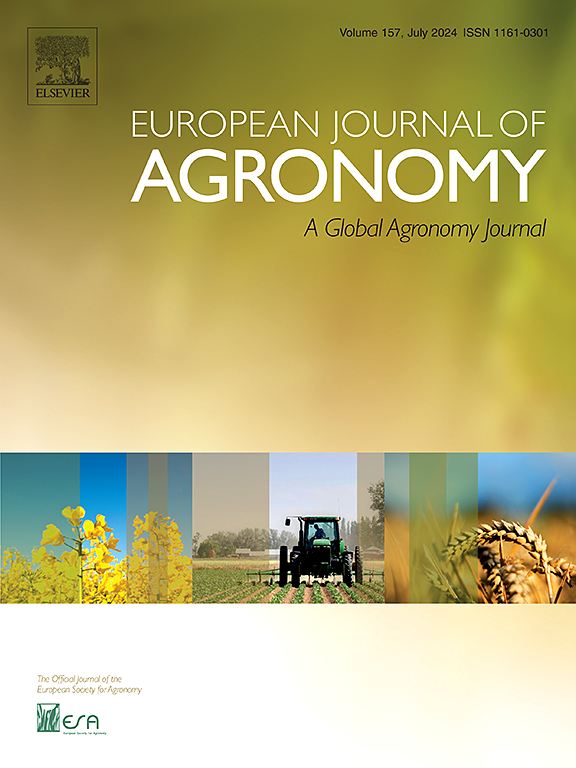Three-dimensional reconstruction and parameters extraction of walnut (Juglans regia L.) branches based on Neural Radiation Fields
IF 4.5
1区 农林科学
Q1 AGRONOMY
引用次数: 0
Abstract
Three-dimensional (3D) reconstruction is important for obtaining morphological information and making intelligent management decisions for fruit trees. Thus, a method for the 3D reconstruction and parameters extraction of branches based on Neural Radiation Fields (NeRF) was proposed for walnut (Juglans regia L.) trees. This approach combined Structure from Motion (SfM) with NeRF and used multi-view images to reconstruct branches. First, a dataset of multi-view images of walnut trees was built and camera poses were obtained using SfM. Second, WalnutNeRF was optimized by incorporating hash encoding, piecewise sampler and appearance embedding features to address challenges associated with complex outdoor environments and accurately reconstruct branches. A scale recovery method using calibration objects was employed to extract branch parameters. The effectiveness of WalnutNeRF was evaluated by analyzing rendering performance, reconstruction efficiency, point cloud quality, and the accuracy of extracted branch parameters. WalnutNeRF outperformed existing methods in terms of the quality of rendered images and the accuracy of estimated depth, as determined using PSNR, SSIM, LPIPS, and other metrics. WalnutNeRF resulted in a branch reconstruction accuracy of 90.94 %, with a training time that was 9-time faster than that of SfM-MVS. Compared with SfM-MVS, WalnutNeRF decreased reconstruction errors for the main branches, lateral branches, and watershoots by 72 %, 67 %, and 57 %, respectively, and decreased the errors in length by 7.09 %, 4.33 %, and 65.07 %, respectively. Accordingly, WalnutNeRF decreased the reconstruction time, while increasing accuracy, providing robust support for the development of intelligent management applications (e.g., intelligent pruning) for walnut trees.
基于神经辐射场的核桃枝三维重建及参数提取
三维重建对于果树形态信息的获取和管理决策的智能化具有重要意义。为此,提出了一种基于神经辐射场(Neural Radiation Fields, NeRF)的核桃树枝三维重建及参数提取方法。该方法将运动结构(SfM)与NeRF相结合,利用多视图图像重建分支。首先,建立核桃树多视点图像数据集,利用SfM获取相机姿态;其次,结合哈希编码、分段采样器和外观嵌入等特征对WalnutNeRF进行优化,以应对复杂户外环境带来的挑战,准确重构树枝。采用标定对象尺度恢复法提取支路参数。通过分析绘制性能、重建效率、点云质量和提取分支参数的准确性来评估WalnutNeRF的有效性。通过使用PSNR、SSIM、LPIPS和其他指标确定,WalnutNeRF在渲染图像的质量和估计深度的准确性方面优于现有方法。WalnutNeRF的分支重建准确率为90.94 %,训练时间比SfM-MVS快9倍。与SfM-MVS相比,WalnutNeRF对主枝、侧枝和水芽的重建误差分别降低了72 %、67 %和57 %,对长度的重建误差分别降低了7.09 %、4.33 %和65.07 %。因此,WalnutNeRF减少了重建时间,同时提高了准确性,为核桃树智能管理应用(如智能修剪)的开发提供了强有力的支持。
本文章由计算机程序翻译,如有差异,请以英文原文为准。
求助全文
约1分钟内获得全文
求助全文
来源期刊

European Journal of Agronomy
农林科学-农艺学
CiteScore
8.30
自引率
7.70%
发文量
187
审稿时长
4.5 months
期刊介绍:
The European Journal of Agronomy, the official journal of the European Society for Agronomy, publishes original research papers reporting experimental and theoretical contributions to field-based agronomy and crop science. The journal will consider research at the field level for agricultural, horticultural and tree crops, that uses comprehensive and explanatory approaches. The EJA covers the following topics:
crop physiology
crop production and management including irrigation, fertilization and soil management
agroclimatology and modelling
plant-soil relationships
crop quality and post-harvest physiology
farming and cropping systems
agroecosystems and the environment
crop-weed interactions and management
organic farming
horticultural crops
papers from the European Society for Agronomy bi-annual meetings
In determining the suitability of submitted articles for publication, particular scrutiny is placed on the degree of novelty and significance of the research and the extent to which it adds to existing knowledge in agronomy.
 求助内容:
求助内容: 应助结果提醒方式:
应助结果提醒方式:


